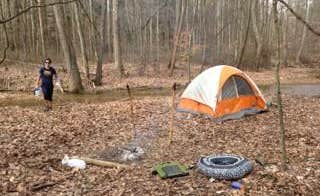Primitive camping options near La Grange, Kentucky require significant preparation. The region contains forested terrain with elevations ranging from 400 to 800 feet and seasonal temperature variations. Most dispersed sites lack facilities and require campers to pack all necessary supplies. Water availability becomes limited during summer months, particularly at higher elevations.
What to do
Hiking exploration: The Knobstone Trail offers numerous primitive camping opportunities along its length. "The entire park is just beautiful. It's very family friendly and quiet. The sites are spacious, and there are a lot of nature things to do," notes Susan C. This trail system provides various difficulty levels suitable for different hiking abilities.
Fossil hunting: Creek beds throughout the camping areas contain abundant fossils. Take time to explore waterways during daylight hours when visibility is best. One visitor at the trail recommends bringing a small brush for cleaning specimens.
Wildlife observation: Dawn and dusk provide optimal wildlife viewing times at Jackson Trailhead. Bird watching is particularly rewarding during spring migration. "There's parking after a decrepit gravel road and suitable for camping," states loganx11, noting the area's rustic nature.
What campers like
Challenging terrain: The topography offers physical challenges that experienced hikers appreciate. The continuous elevation changes provide workout-quality hiking with natural terrain features rather than maintained paths in many areas.
Solitude opportunities: Free camping near La Grange, Kentucky often means fewer crowds compared to established campgrounds. Many campers report having entire sections of trail to themselves, especially on weekdays and during shoulder seasons.
Navigation practice: The trail system requires map reading skills and provides an excellent opportunity to practice navigation. Trail junctions are typically marked but sometimes require careful attention. Some hikers recommend downloading offline maps before arrival.
What you should know
Access limitations: Some trailheads have restricted vehicle access. "Maybe Google Maps took me to the wrong place. I drove back and forth on the road several times looking for this place. The only thing I found was what I believe was the entrance with a cable across it," reports Desert B. regarding the Knobstone Trail. Always verify current access conditions before departure.
Water filtration necessity: All water sources require treatment. Seasonal streams may dry completely during summer months. Pack adequate water capacity and reliable filtration systems.
Tick prevention: Insect activity intensifies during spring and summer months. Wear appropriate clothing and check for ticks daily. Use repellent on outer layers of clothing for added protection.
Tips for camping with families
Site selection strategy: Choose camping locations near trail intersections. This provides easier exit options if weather changes or emergencies occur. Most family-friendly spots are within the first 2-3 miles of trailheads.
Skill-building activities: Use dispersed camping as an opportunity to teach outdoor skills. Simple knot tying, map reading, and wildlife identification can engage children while developing practical knowledge.
Pack weight considerations: Distribute gear appropriately among family members based on age and ability. Children as young as 5-6 years can carry light items like their sleeping bag or personal clothing.
Tips from RVers
Alternative base camps: No dispersed camping areas near La Grange accommodate large recreational vehicles. Consider established campgrounds as a base camp for day trips to hiking areas instead of attempting to reach trailheads with larger vehicles.
Road condition awareness: Gravel access roads deteriorate significantly after rain. Many become impassable for vehicles without adequate clearance. Always check recent weather and road conditions before attempting access with any vehicle larger than a standard SUV.


